Researchers from the American Chemical Society have developed a biodegradable magnetic millirobot that exhibits insect-like flexibility

Millirobots already exist and are being used for various biomedical applications such as drug delivery or carrying out minimally invasive surgery. These mini robots are fabricated using non-degradable materials such as silicon hence, it is removed after implementing surgical procedures, these materials are not flexible and limit their adaptability. Hence, In a paper published in ACS Applied Polymer Materials, a team of researchers from China has described soft, biodegradable millirobots that are flexible enough with walking and grabbing capabilities like insects.
The researchers created a millirobot using gelatin solution mixed with iron oxide microparticles. The material is placed above the permanent magnet that forces the microparticles in the solution to pushing gel outwards, forming insect-like “legs” along the lines of the magnetic field. The hydrogel is placed in a cold region to make it solid. The final step is to soak the material in ammonium sulfate to cause cross-linking in the hydrogel, making it more stronger. The researchers were able to tune the properties by altering the composition of ammonium sulfate solution, the thickness of the gel, or the strength of the magnetic field. For eg, placing the hydrogel far from the magnet resulted in fewer but longer legs.
The iron oxide microparticles form magnetic chains within the gel, when a magnet is moved near the hydrogel, the legs bend and produce a claw-like grasping motion. The researchers tested that the material could grip a 3D-printed cylinder and a rubber band and carried them to new locations. Also, the researchers experimented with the millirobot’s ability to deliver a drug by coating it in a dye solution, then rolling it through a stomach model. The robot unfurled and released the dye using magnets, once it has reached its destination. The millirobot easily gets degraded in two days leaving only the tiny magnetic particles as it is made up of water-soluble gelatin.
The researchers envision that these new gelatin millirobots will find new prospects for drug delivery and other biomedical applications.
Click for the Published Research Paper and Video






